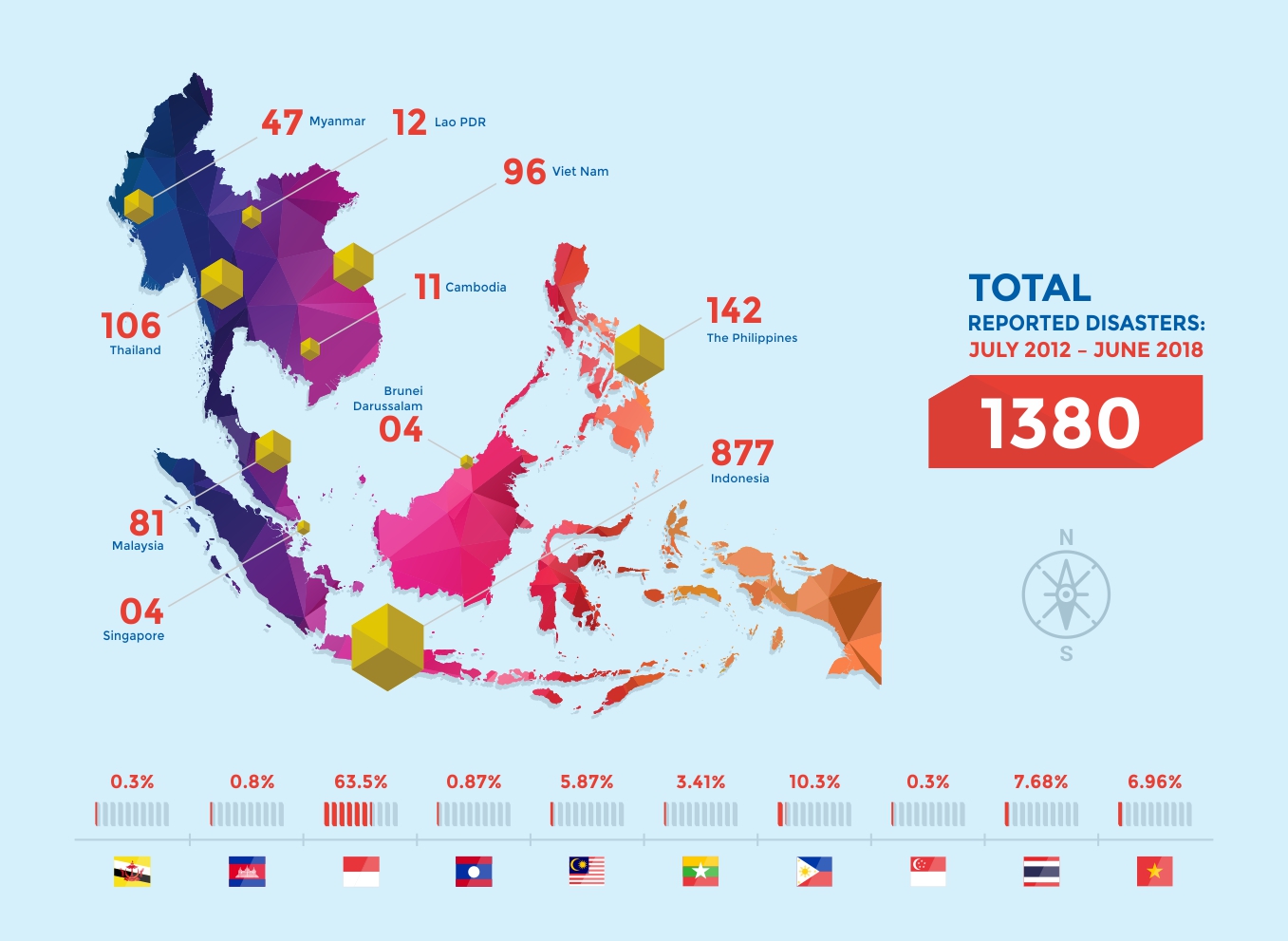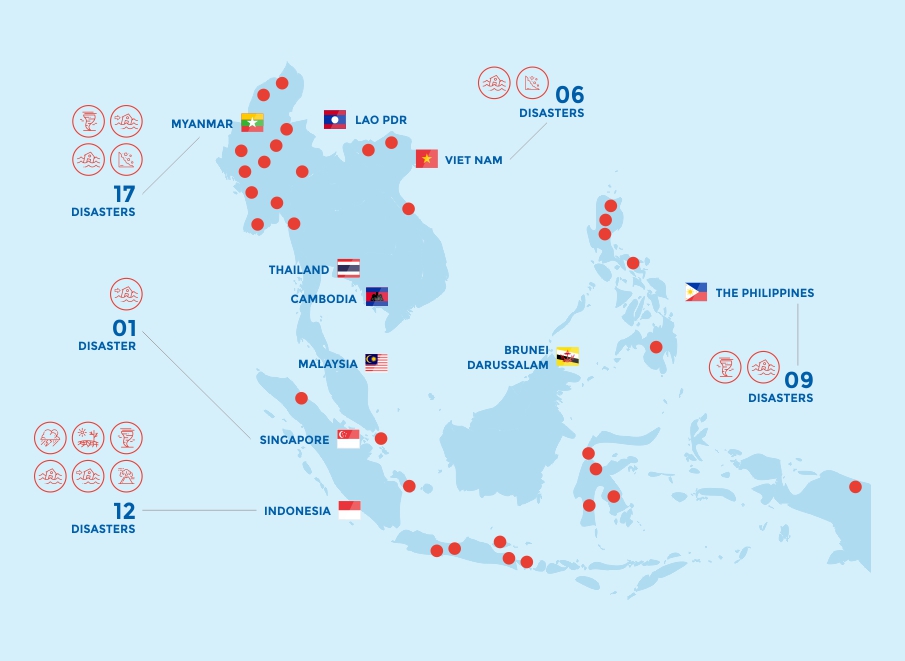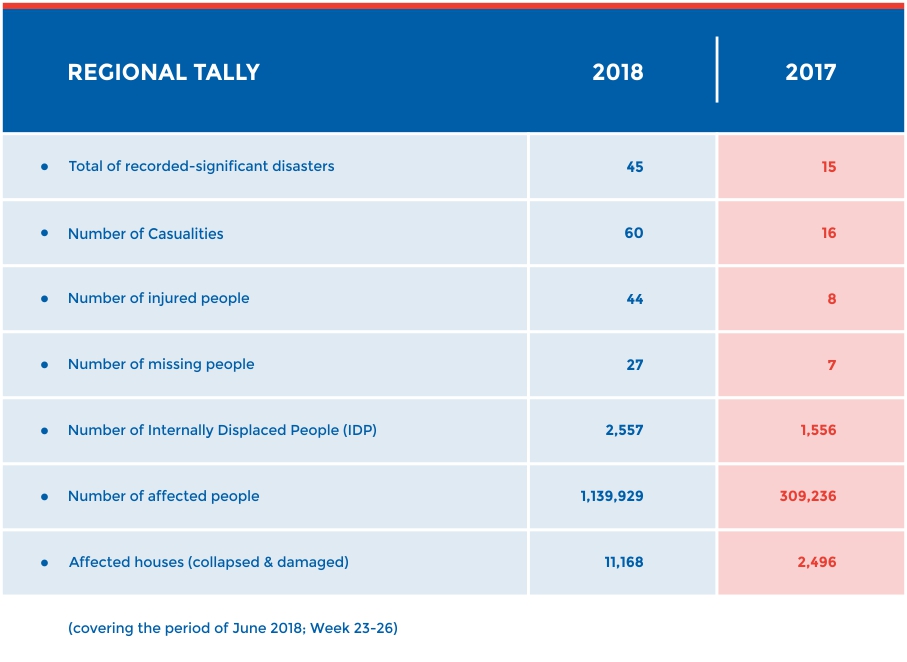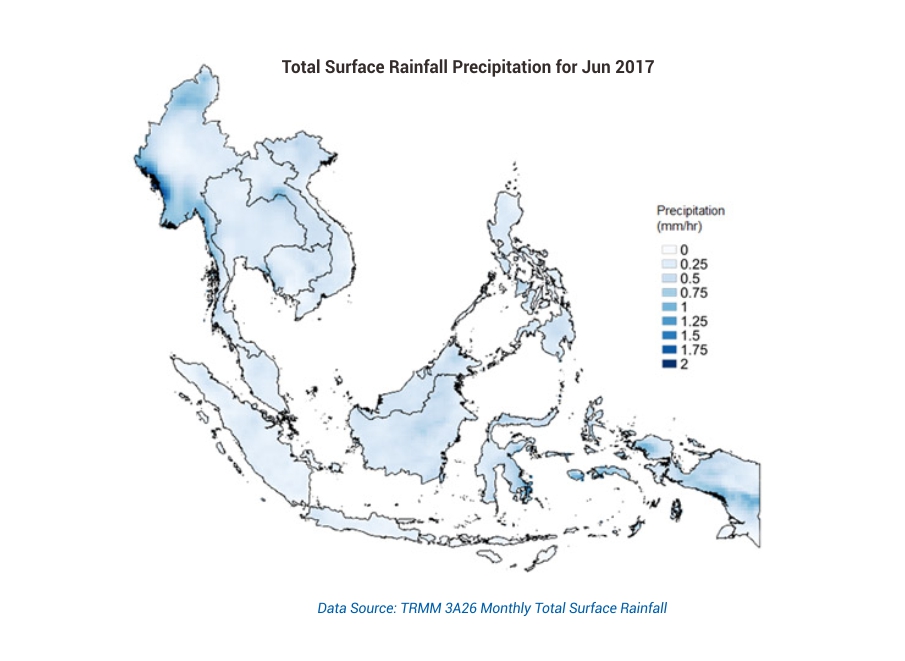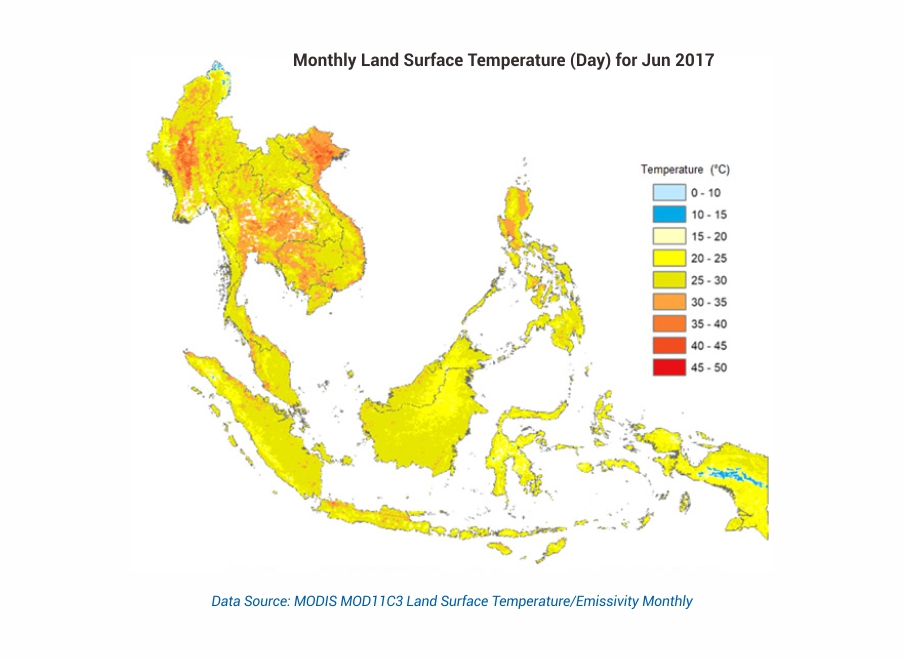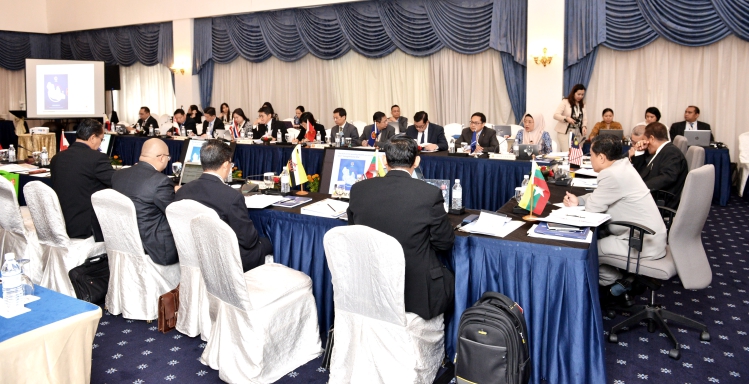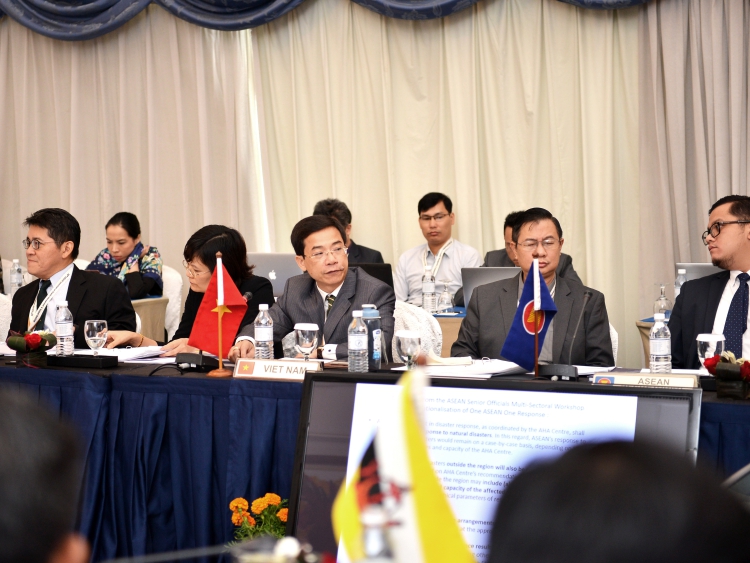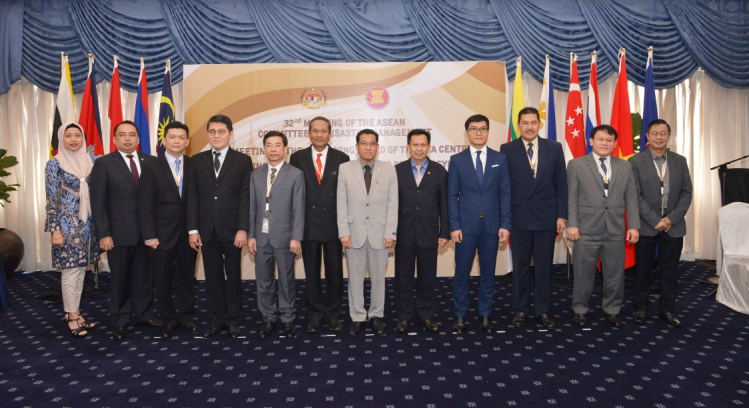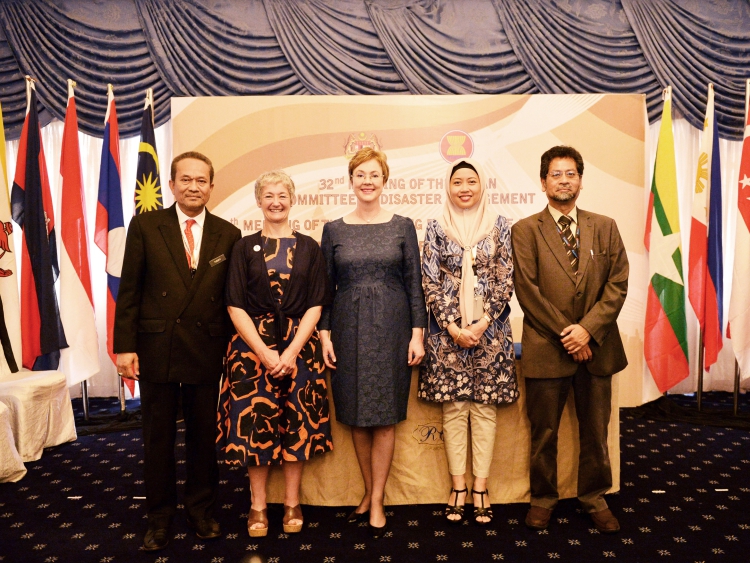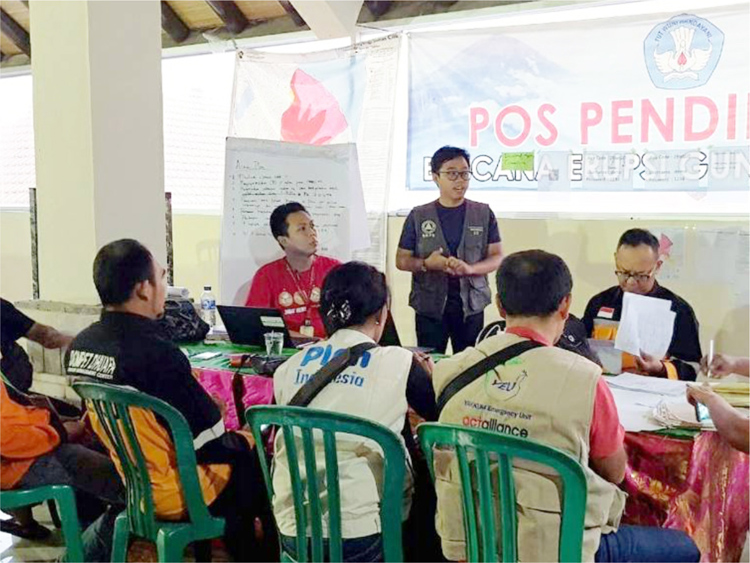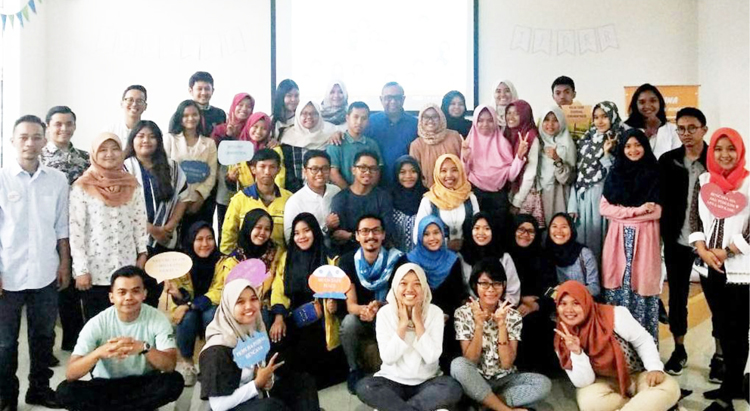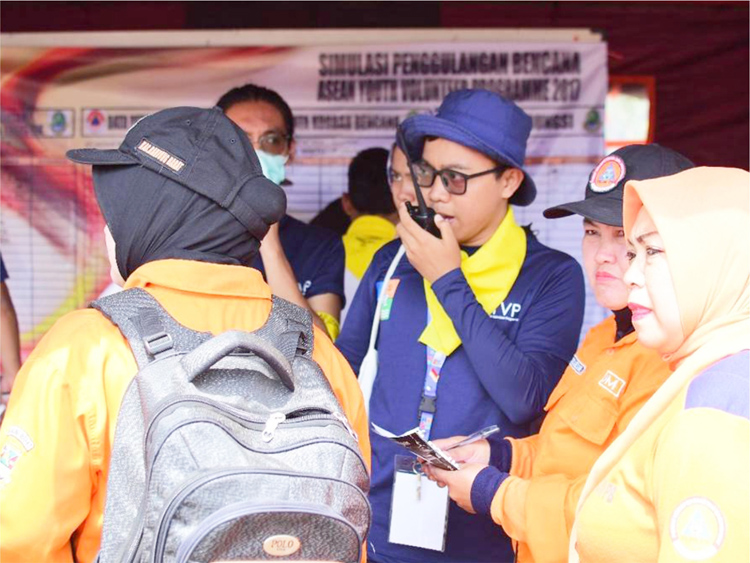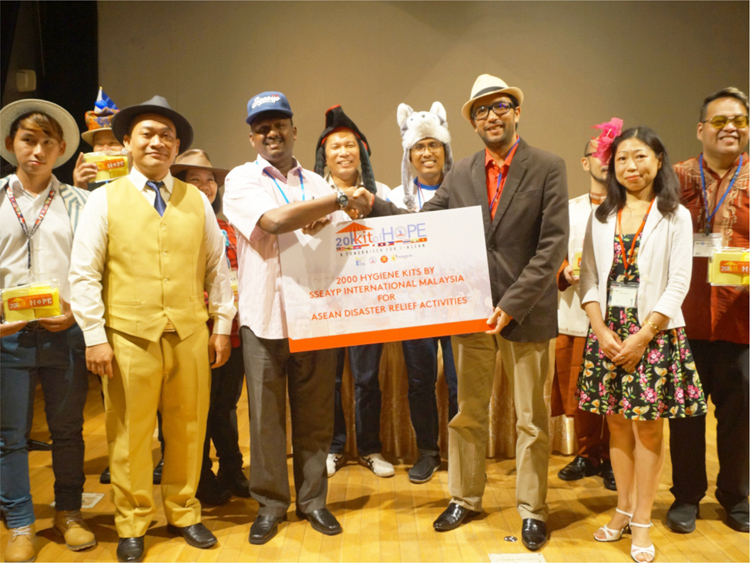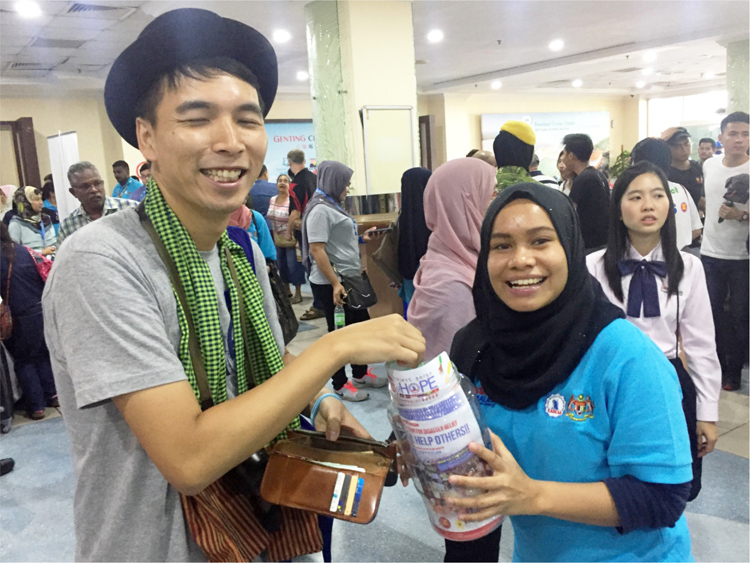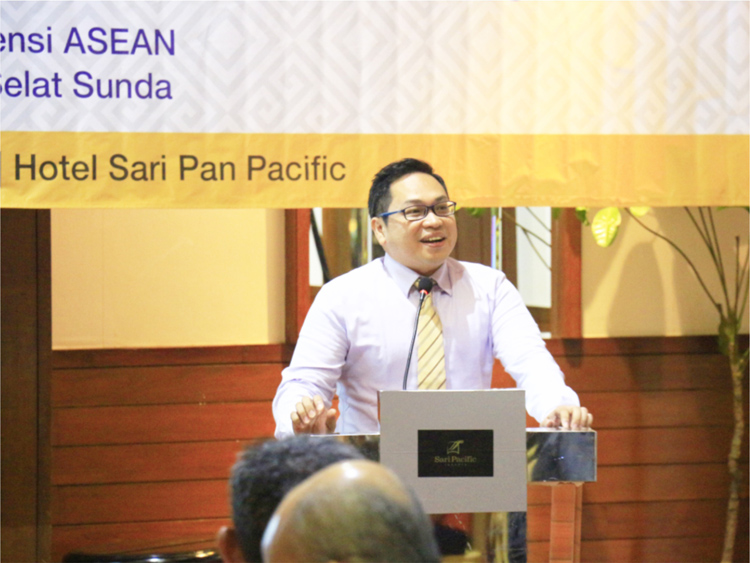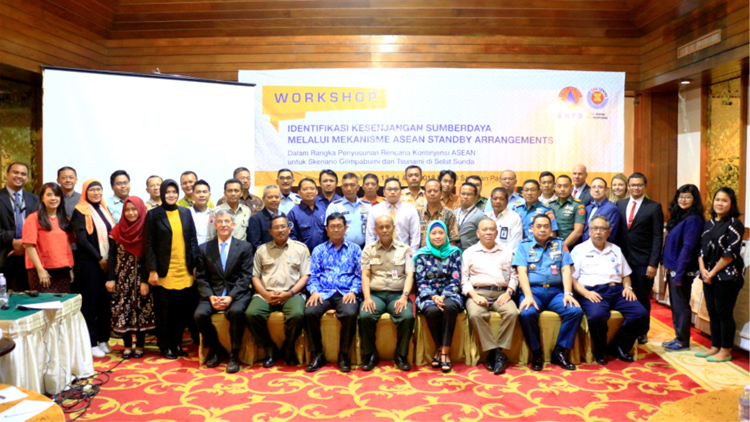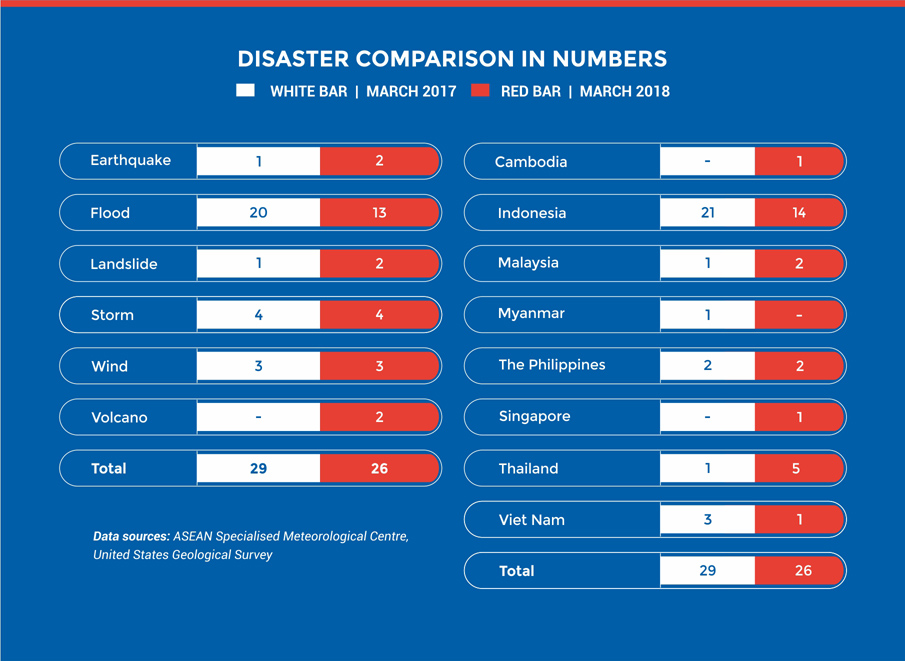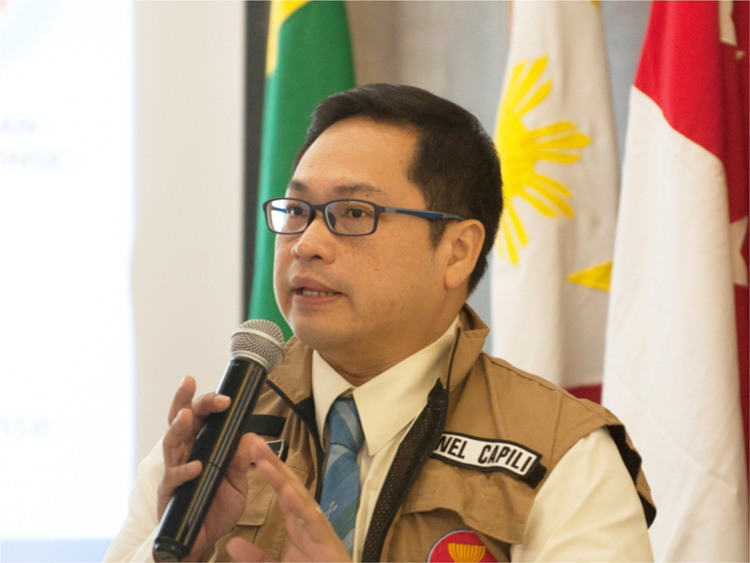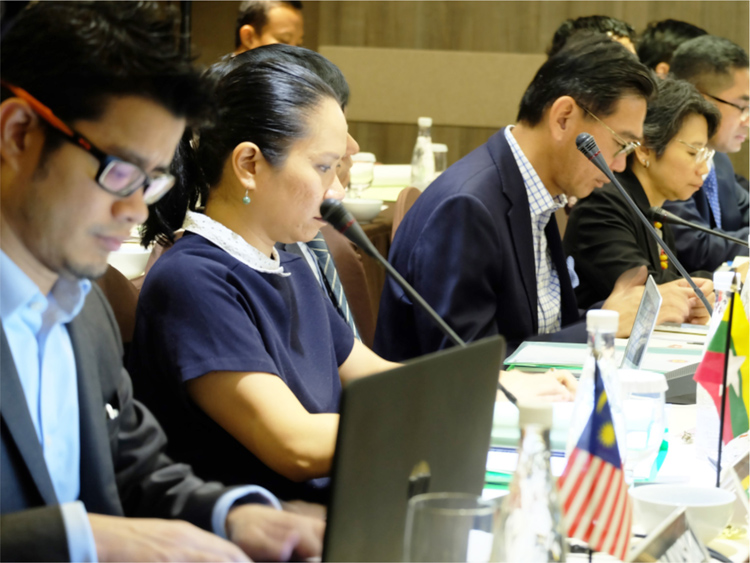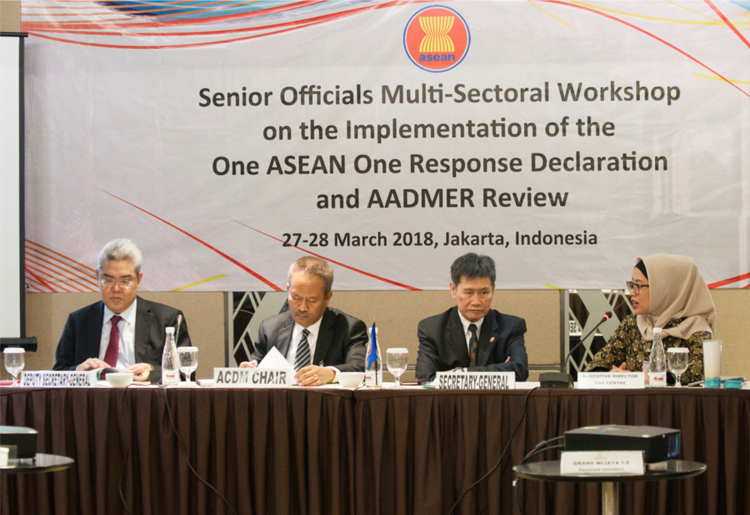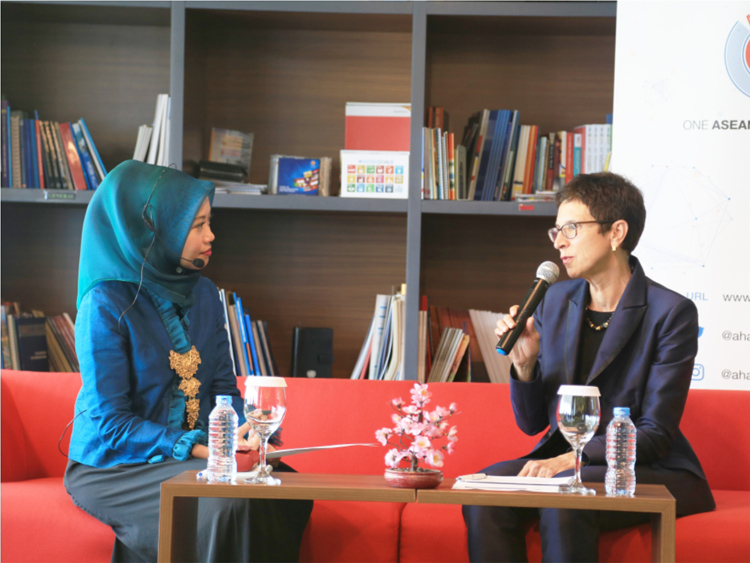Vol 40-Total Reported Natural Disaster in Southeast Asia

TOTAL REPORTED
NATURAL DISASTERS IN SOUTHEAST ASIA
JULY 2012 – JUNE 2018
The AHA Centre has been monitoring disasters across ASEAN since its establishment in 2011. This month, we present a snapshot from consolidated data of recorded disasters that have taken place in the ASEAN region throughout the past six years.
As can be seen, the occurrence of disaster in Indonesia is extremely high, due much to its location on the ‘Ring of Fire’ – with its high tectonic activity – resulting in ongoing threats from earthquakes and volcanoes, alongside hydro-meteorological events such as flooding and landslides. Nations such as Malaysia, the Philippines, Thailand and Viet Nam have also experienced high numbers of disasters, often as a result of monsoonal seasons and heavy rainfall. Even for nations with lower numbers, the risk of disaster remains high. Due to ongoing optimisation of AHA Centre’s monitoring systems, as well as improving regional disaster classifications and reporting mechanisms, localised disasters may have previously been under-reported, with numbers for many nations potentially higher than displayed above. This highlights the importance of the AHA Centre’s existence, to support the skills development and increase capacity of Member States to prepare, monitor and respond to disasters of all varieties and at a world-class level.
Written by : Shintya Kurniawan, William Shea
DISCLAIMER
The presented information above is consolidated from the ASEAN Disaster Information Net (ADINet) and the Emergency Events Database (EM-DAT).
- Published in Insight
Vol 40-Monthly Disaster Review and Outlook

MONTHLY DISASTER REVIEW AND OUTLOOK
JUNE 2018 | DISASTER MONITORING & ANALYSIS
(DMA) UNIT, AHA CENTRE
GENERAL OVERVIEW OF JUNE 2018
There was a three-fold increase in the number of disasters recorded during June 2018 (45 in total) in comparison to the same time during 2017 (15 disasters). An onset of numerous weather events caused this spike in disasters, with the southwest monsoons, Tropical Depression (TD) Domeng, TD Ewiniar, TD Ester and TS Florita causing floods and landslides throughout the Philippines, Viet Nam and Myanmar. In contrast, several areas south of the equator, particularly Indonesia’s Central Java and Yogyakarta provinces, have experienced the onset of drought conditions, consistent with the shift to the region’s dry season. This such phenomena indicates a similar pattern to 2017, which saw northern parts of ASEAN experiencing wet season floods, while southern parts experienced dry season drought events (see Figure 1) . Overall, 20 flood events, 11 storms and 4 wind-related disasters were recorded throughout June 2018.
In terms of geological hazards, 26 earthquakes registering ≥ M 4.5 were observed across Indonesia and the Philippines. However, only two were strong enough to cause property damage (East Java and Papua provinces of Indonesia, on the 13th and 15th of June respectively. Towards the end of June 2018, concerns were raised due to increased activity reported on Bali’s Mount Agung, which released ash plumes and resulted in a strombolian-type eruption.
OUTLOOK FOR JULY-AUGUST 2018
According to the ASEAN Specialised Meteorological Centre (ASMC), most parts of the ASEAN region will continue to experience wet weather, as the rain band associated with Typhoon Prapiroon affects the region. Hotspot activities have remained subdued, but isolated events have been detected in Viet Nam and Lao PDR. During the first week of July, dry weather is expected to affect Java, and may exacerbate the ongoing drought events. Aside from such southern areas, wet weather is likely to persist over other parts of the ASEAN region. For tropical cyclone (TC) forecasts, the Philippine Atmospheric. Geophysical and Astronomical Services Administration (PAGASA) expects that 10-14 TCs will form and enter the Philippine Area of Responsibility throughout the six months between July and December 2018.
Close and continuous monitoring is still required for Mount Sinabung (Alert Level IV) and Mount Agung (Alert Level III) in Indonesia, particularly due to historic Mount Agung eruptions, which lasted up to one year during 1963-1964.
Written by : Mizan Bisri, Qing Yuan Pang
DISCLAIMER
AHA Centre’s estimation is based on data and information shared by National Disaster Management Organisations (NDMOs) and other relevant agencies from ASEAN Member States, international organisations and news agencies. Further information on each recorded-significant disaster, description and details of data and information are available at: http://adinet.ahacentre.org/reports.
- Published in Monthly Disaster Outlook
Vol 40-The 8th Meeting of The Governing Board of The AHA Centre

THE 8th MEETING OF
THE GOVERNING BOARD OF THE AHA CENTRE
The latest series of meetings of the ASEAN Committee on Disaster Management (ACDM) and the Governing Board of the AHA Centre focused towards the continuing vision of ASEAN nations to become global leaders in disaster management. The meetings discussed a number of ongoing initiatives, as well as past achievements in disaster management, alongside the future disaster management plans for the ASEAN region.
This integral series of meetings was officially opened by Malaysia’s Deputy Prime Minister, the Honourable Dato’ Seri Dr. Wan Azizah binti Wan Ismail, who commended ASEAN on its various achievements in disaster management, while also reiterating the work that still must be done. She highlighted particular concerns regarding the plight of women during disaster situations, calling on ASEAN nations to continue efforts to mainstream gender within disaster management efforts.
Achievements highlighted by the Governing Board included the decision that the AHA Centre would provide humanitarian assistance support to the survivors of human-induced disasters. Throughout 2017, and continuing into 2018, the AHA Centre provided humanitarian assistance to displaced populations in Marawi, the Philippines and the Rakhine state, Myanmar. This evidenced the AHA Centre’s efforts to ‘go the extra mile’, as the original mandate of the AHA Centre focuses on providing assistance to victims of natural disasters. In this situation however, the AHA Centre recognised the need to be adaptable and flexible in recognition of the ever-evolving landscape and increasing complexity of disaster management in the region.
During the meeting, ASEAN nations also reaffirmed their commitment to support the operationalisation of One ASEAN One Response Declaration – signed in 2016 – that calls for an increase in speed, scale and solidarity of ASEAN collective response to major disaster within and outside the ASEAN region. The AHA Centre, as the operational engine of the ASEAN Agreement on Disaster Management and Emergency Response (AADMER), has taken a number of initiatives to further enhance the operationalisation of the Declaration, including the formulation of the ASEAN Joint Disaster Response Plan (AJDRP).
Another highlight from the meetings were the various initiatives to improve the capacity of the disaster professionals in the region through various capacity building activities, including the ASEAN Emergency Response and Assessment Team (ASEAN-ERAT) training, as well as the AHA Centre Executive (ACE) Programme. In addition to this, ASEAN is currently working to kick-start the ASEAN Standards and Certification for Experts in Disaster Management (ASCEND). Through this programme, ASEAN aims to set common standards and qualifications for disaster management professionals, as well as develop a standard training curriculum. By agreeing on common standards, ASEAN will ensure the availability of qualified disaster management professionals in the region, further supporting the vision of ASEAN becoming a global leader in disaster management.
On the side-lines of the event, the Governing Board also witnessed the signing of three Memoranda of Intent (MoI) between the AHA Centre and key strategic partners – namely MERCY Malaysia, RedR Australia and MapAction.
These MoI signings signify the commitment between AHA Centre and the partners to further strengthen, compliment and support each other in areas of mutual interest on disaster management. Several areas covered under the MoIs include knowledge exchange and management, innovation and joint fundraising efforts, disaster monitoring and analysis, and recovery.
All of these were discussed during the 32nd Meeting of the ACDM and other related meetings that took place from the 26th to the 28th of June 2018, in Kuala Lumpur, Malaysia. This also included the 8th Meeting of the Governing Board of the AHA Centre on the 27th of June, the 9th Meeting of the Joint Task Force to Promote Synergy Other Relevant ASEAN Bodies on Humanitarian Assistance and Disaster Relief (HADR), and the 5th ASEAN Agreement on Disaster Management and Emergency Response (AADMER) Partnership Conference. During this event, the AHA Centre also presented its 2017 Annual Report, which documents the progress, achievements, and plans for further enhancement of the roles and responsibility of the AHA Centre.
Written by: Carla Budiarto, Dipo Summa | Photo: AHA Centre
- Published in Highlight
Vol 37-Fajar Shidiq

Fajar Shidiq
Co-Founder & Chairman, Indonesian Youth on
Disaster Risk Reduction
THE INDONESIAN YOUTH ON DISASTER RISK REDUCTION (IYDRR) FORUM BEGAN TO TAKE SHAPE IN 2015, AS A GROUP OF JAKARTA UNIVERSITY STUDENTS PARTICIPATING IN DISASTER MANAGEMENT ACTIVITIES RECOGNISED THE NEED, AND THE OPPORTUNITY, TO INCREASE THE ALL-IMPORTANT ENGAGEMENT OF YOUTH THROUGHOUT DISASTER MANAGEMENT PRACTICES. IYDRR’S CO-FOUNDER AND CHAIRMAN, FAJAR SHIDIQ, SPOKE TO THE AHA CENTRE ABOUT HIS EXPERIENCE IN EXPANDING THIS STRATEGIC AND MODERN MOVEMENT.
“We all kept meeting at disaster management events– it was like ‘you again, you again,’–always the same people,” Fajar recalls of his participation in disaster management activities during his early university days. “In 2015 we started discussions about creating something more formal and united, and in late 2016 IYDRR was established.”
While still relatively new, the organisation has already begun to engage strongly with the wider national disaster management movement, and even dipped its toes into regional and international circles. However, Fajar highlights the importance of developing a strong presence locally, as the organisation continues to advance its presence within the Indonesian disaster management sector. Youth were traditionally more engaged in response efforts, as volunteers. However, with more recent inclusion in other disaster management aspects–such as policy development and decision-making–such youth groups starting to gain more opportunities to engage. Examples of this increase include the engagement of youth within the ASEAN-ERAT Induction Courses, with the AHA Centre recognising the importance of youth participation within One ASEAN, One Response efforts.
Fajar sees a variety of positive elements for increased youth engagement within overall disaster management processes. The range of backgrounds and skills offered by youth organisations, such as IYDRR, can be of great benefit for the disaster management sector. Members are studying, or hold degrees, from a wide range of study areas, all of which can be valuable within disaster management efforts. Such a context opens the door for organisations such as IYDRR to provide great value within its key working areas of capacity development, advocacy and community empowerment, and for the voice of youth to be commonplace within all aspects of disaster management. “This is what we are pushing for, slowly of course, but to have a stronger engagement in all aspects of disaster management. We want the youth to have a voice.”
While the organisation works with extremely limited funding and relies heavily on the passion and time provided by its more than 100 members, a range of achievements have already begun to appear. Fajar highlights the design of infographics–and ultimately the use of these tools after the 2018 Jakarta earthquake–as a key example of what was perhaps considered a small and unimportant activity holding great final value. “After the earthquake these infographics were being shared everywhere–people were contacting us and requesting we send them,” he recalls. It is such outcomes that IYDRR hopes to replicate and expand, with an aim to develop a range of tools to support disaster risk reduction and response for communities, particularly in urban areas. “When you look at the SDGs, it’s clear urban areas are high-risk” he comments. “This is an area that needs to be strengthened, and therefore we want to focus heavily on supporting such efforts.” In the era of technological advancement, coinciding with unprecedented growth in technological use, such efforts fit perfectly with the skills held by youth organisations such as IYDRR.
As the organisation becomes increasingly engaged within the national, regional, and even international disaster management field, Fajar hopes that the importance, value, and capacity of youth will also be increasingly recognised, accepted and used to advantage by all stakeholders within the sector. “If you provide space for youth, provide opportunity, they may do something that you never imagined possible.”
Written by : William Shea | Photo: AHA Centre, IYDRR
- Published in The Other Side
Vol 37-Kit of Hope Fun Crowdfunding

KIT OF HOPE
FUN CROWDFUNDING
SUBANG, MALAYSIA, 5 MARCH 2018
Collaboration lies at the heart of One ASEAN One Response solidarity. Beyond a slogan, such solidarity asserts that every individual can contribute in the development of a collective resilience towards natural disaster. Alumnae of the Ship for Southeast Asian and Japanese Youth Programme (SSEAYP) in Malaysia demonstrated a similar spirit earlier this year, through a fundraising drive to support emergency response efforts in the region.
In late 2017, the SSEAYP Malaysia Chapter ran an independent crowdfunding campaign to celebrate the 50th anniversary of ASEAN, as well as the 45th year of cooperation between Japan and the ASEAN region. The campaign successfully secured funding to provide 10 thousand hygiene kits for the ASEAN standby relief stockpile – warehoused in Subang, Malaysia. Each hygiene kit comprises of sanitised wet wipes, shampoo, soap, face towel, toothbrush, sanitary pads, and a plastic comb. Not only did they fund the procurement of the relief items, members of SSEAYP International Malaysia also volunteered to pack the donations – that were handed over to the AHA Centre on March 5th, 2018.
“This is a good example of ASEAN solidarity where students raised money and contributed relief items in the spirit of One ASEAN One Response. It is an inclusive platform so everyone is welcome to join and contribute,” said Ms. Adelina Kamal, Executive Director of the AHA Centre.
SSEAYP was launched in 1974 by the Government of Japan to promote cross-cultural understandings between youth of all ASEAN Member States and Japan. The annual exchange programme allows participants to get to know each other through a two-month voyage on the Nippon Maru vessel.
“It was a great relief to see corporations, government agencies and ministries to also chip into the crowd-funding campaign. We had also received individual contribution from students and visitors of the Open Ship of SSEAYP in December 2017. But biggest applause is to the SSEAYP International members attending the Reunion on Board dinner, of which part of the tickets sold were routed to this effort,” said Dyana Abas, the Deputy President of SSEAYP International Malaysia, who was also the 20K Kit of Hope Program Chairperson.
Written by : Shintya Kurniawan | Photo: SSEAYP International Malaysia
- Published in AHA Centre Diary 2
Vol 37-Contingency Planning Workshop

CONTINGENCY
PLANNING WORKSHOP
JAKARTA, 13-14 MARCH 2018
In Jakarta on 13-14 March 2018, the AHA Centre engaged about 50 participants in a two-day ASEAN Contingency Planning workshop for Indonesia. Participants came from different Indonesian line ministries involved in disaster response and disaster management, including the National Disaster Management Authority (BNPB), the Local Disaster Management Agency (BPBD), the Meteorology, Climatology, and Geophysics Body (BMKG), the Department of Defence, the army, the Transportation Department, and the Ministry of Health.
Using a scenario of a large tsunami hitting the industrial city of Cilegon, the participants managed to identify at least 31 items, consisting of assets and capacities, that were categorised as immediate needs by the affected population. Included in the identified items are medicine, emergency medical teams, urban search and rescue teams, water treatment facility, and the needs of vulnerable groups: nutritious food for infants, breastfeeding mothers, and aid for people with disabilities. The workshop also stimulated discussions on transportation and logistics access, that would serve to enable timely distribution of humanitarian assistance from ASEAN Member States and partners.
The workshop is part of the AHA Centre’s effort to continue the development of the ASEAN Joint Disaster Response Plan (AJDRP). The AJDRP has identified three major disaster risks in the region–a major earthquake in Metro Manila, a super cyclone in the Ayeyarwady Delta in Myanmar, and tsunami caused by a megathrust earthquake in Indonesia. Three workshops, with Jakarta being the final, have now been undertaken using these scenarios, in order to enhance the speed, scale, and solidarity of ASEAN’s collective response to major disasters in the region. Similar workshops have been conducted in Manila, the Philippines, and Nay Pyi Taw in Myanmar in 2017.
With the conclusion of the workshop in Jakarta, the AHA Centre is now able to identify common needs in large-scale disasters, and consider how ASEAN can support the affected Member State(s) at such a time. However, it is important to highlight that any disaster response operation should always be nationally led, regionally supported, and internationally reinforced as and when necessary.
Arnel Capili, the Director of Operations of the AHA Centre, noted that ASEAN can only engage effectively if a relationship of trust has been developed within all the Member States. “We can only operate on the speed of trust”, he remarked, “which is why it is important to continue the dialogue, to build on what we already have, and move forward from there.”
Written by : Shintya Kurniawan | Photo : BNPB
- Published in AHA Centre Diary 1
Vol 37-Thailand

THAILAND
Thailand is often known as the heart of Southeast Asia, as it lies in the centre of the ASEAN Region, sharing borders with Cambodia, Lao PDR, Malaysia, and Myanmar. The nation is home to a variety of geographical features – including mountains, flatlands, coastal regions, rivers and wetlands – with its proximity to the equator ensuring a hot and steamy climate throughout most of the year, with a climate controlled by tropical monsoons.
While the risk of natural disaster in Thailand is generally lower than the rest of the ASEAN nations due to land masses in the east providing protection from typhoons, and the fact that the country does not lie on a tectonic plate boundary – the interaction between humans and the environment often sees Thailand experience high occurrence of disaster from natural hazards. Floods, drought and landslides disasters are often the result of this complex interaction between humans and their surrounds.
FLOOD
Without doubt, flood forms the greatest natural hazard to Thailand and its citizens, with all regions throughout the country prone to experiencing disaster events and damages due to flooding. There is flash-flooding in the river basins of the south and central deltas, monsoonal floods in Thailand’s coastal regions, and flooding in mountainous areas as the arid land struggles with absorbing the rain caused by unstable mountainous weather systems. High numbers of communities living along the nation’s rivers and coast often feel the full force of these yearly occurrences. Between 1987 to February 2018, Thailand experienced 77 flood events, impacted the nation’s population and economy.
DROUGHT
Accelerated by the impact of a changing climate, drought events have become increasingly prevalent in Thailand, particularly in the nation’s central and eastern regions. The months between January and May often see drought conditions become increasingly severe, as communities await alleviation through the onset of the monsoon season. Drought in Thailand has a significant impact on the nation’s agricultural industry, and consequently can affect the country’s food supply and economy. Alongside this, weather anomalies have also resulted in severe drought emergencies. For example, El Niño in 2014 impacted over 20,000 villages in Thailand’s north, having a run-on effect to agricultural production, food supplies and the nation’s economy.
LANDSLIDE
Landslides form a significant hazard for Thailand’s mountainous northern and eastern regions, as the struggle between arid lands due to the dry season and the onset of monsoonal rains plays out. This struggle often results in large and unexpected landslides, at times amplified by the existence of land degradation due to deforestation. With such events occurring in more remote, mountainous locations, vulnerable populations tend to be from rural commu-nities, and impacts are often further accentuated due to poor building practices within these remote villages. 2011 saw Thailand’s worst landslide event, with an entire village engulfed by mudflow, with 110 residents lost their lives due to the unexpected natural disaster.
Written by : William Shea
All information sourced from ‘Viet Nam Disaster Management Reference Handbook: 2015’, as developed by the Center for Excellence in Disaster Management and Humanitarian Assistance (CFE-DM).
- Published in Insight
Vol 37-Monthly Disaster Outlook

MONTHLY DISASTER REVIEW OUTLOOK
MARCH 2018 | DISASTER MONITORING & ANALYSIS
(DMA) UNIT, AHA CENTRE
GENERAL OVERVIEW OF MARCH 2018
Hydro-meteorological disasters, particularly floods, strong winds and storms, continued to dominate disaster occurrence figures in March 2018. During the month, flash-flooding events due to extreme rainfall within a short amount of time, occasionally triggering landslides as a secondary disaster, as evident in several events across Indonesia. Localised strong winds and storms caused damage in Cambodia, Singapore, Thailand and Viet Nam.
In terms of geological hazards, moderate-to-strong earthquakes (≥ M 5.0) were observed in Indonesia, Malaysia and the Philippines, triggering minor local disruptions without having a significant impact on communities. The ASEAN Earthquake Information Center (AEIC) recorded four earthquakes with a magnitude stronger than M 6.0, three of these-originating in Papua New Guinea – were felt as far across as the Papua Province of Indonesia. Volcanic activities of Mount Mayon in the Philippines continued to affect more than 90,000 people in the nearby Albay Province. On Mount Sinabung, Mount Ijen and Mount Dieng (in East and Central Java provinces Indonesia), toxic gas releases were recorded, and while there were no significant eruptions, the release on Mount Ijen prompted a mandatory evacuation of local communities.
OUTLOOK FOR APRIL-MAY 2018
According to the ASEAN Specialised Meteorological Center (ASMC), the April-May 2018 season can expect slightly below-normal to near-normal rainfall. This is forecasted for most parts of Southeast Asia, except the Philippines. During April 2018, slightly above-normal rainfall is forecast over the northern regions of Kali-mantan and Sulawesi, and western parts of Papua in Indonesia. Towards May 2018, slightly below normal rainfall is expected for most parts of Kalimantan (Indonesia, Malaysia and Brunei Darussalam), Sumatra, Java, Bali and the Nusa Tenggara archipelago of Indonesia. ASMC also stated that there is around 60% chance of La Niña conditions lasting until to end of April 2018, and then a return to neutral conditions during May.
Indonesian Centre for Volcanology and Geological Disaster Mitigation PVMBG states that for April 2018, areas in western Sumatra, south of central Java, north-eastern Borneo, eastern Sulawesi and northern Papua will be prone to ground movement inducing, landslide events. Continuous monitoring for potential humani-tarian consequences will also be required due to the activity of Mount Sinabung (‘PVMBG’s arlet level: warning) and Mount Agung (‘PVMBG’s arlet level: watch) in Indonesia, as well as Mount Mayon and Mt. Kanlaon (PHIVOLCS’ alert level 2, – moderate level of unrest) in the Philippines. Moderate-to-strong earthquakes are still expected in the bordering region between Papua (Indonesia) and Papua New Guinea.
Written by : Mizan Bisri, Qing Yuan Pang
DISCLAIMER
AHA Centre’s estimation is based on data and information shared by National Disaster Management Organisations (NDMOs) and other relevant agencies from ASEAN Member States, international organisations and news agencies. Further information on each recorded-significant disaster, description and details of data and information are available at: http://adinet.ahacentre.org/reports.
- Published in Monthly Disaster Outlook
Vol 37-ASEAN Workshop on The Implementation of ONE ASEAN ONE RESPONSE

ASEAN WORKSHOP
ON THE IMPLEMENTATION OF ONE ASEAN ONE RESPONSE
Remaining focused on responding to natural disasters in the ASEAN region, alongside planning for facilitating potential collective ASEAN responses outside of the region form the key recommendations for the AHA Centre. These points were deliberated by participants of the ASEAN Senior Official Multi-Sectoral Workshop on One ASEAN One Response, organised by the ASEAN Secretariat, from the 27th to 28th of March 2018. Representatives from a wide range of ASEAN sectoral bodies attended the workshop, including from the Country Permanent Representatives (CPR), the ASEAN Committee on Disaster Management (ACDM), representatives from the Senior Official Meeting (SOM), ASEAN Defense Senior Official Meeting (ADSOM), Senior Official Meeting on Health Development (SOMHD), Senior Official Meeting on Social Welfare and Development (SOMSWD), as well as other relevant ASEAN entities and partners.
The principal purpose of this meeting–as highlighted by the ASEAN Secretary-General H.E. Lim Jock Hoi during his opening address–was to engage the views of a range of stakeholders in more prominently defining the functions of the Declaration, as well as providing clarity to requirements for current and future humanitarian challenges faced by the ASEAN region.
The One ASEAN One Response Declaration, signed by the ASEAN Leaders in 2016, reaffirms the commitment of ASEAN nations to respond collectively to major disasters in the region as one, in order to achieve faster speed, greater resources and stronger coordination. It also reaffirms the position of the AHA Centre as the primary regional coordinating agency on disaster management and emergency response, as well as tasks the AHA Centre to establish coordination mechanisms with other East Asian Summit (EAS) participating countries to enable them to provide assistance to ASEAN countries affected by disasters. The Declaration also envisions a future where ASEAN countries can collectively provide assistance to countries outside of the ASEAN region, and tasks the AHA Centre with preparing for such engagement.
The AHA Centre used this opportunity to update workshop participants on recent progress made by the AHA Centre in operationalising the One ASEAN One Response Declaration. The Director of Operations of the AHA Centre, Arnel Capili, presented a range of tools and concepts that the AHA Centre has developed throughout recent years, supported by strategic guidance from the ACDM. Such processes, amongst others, include the Joint Operations and Coordination Centre of ASEAN (JOCCA), the Web Emergency Operation Centre (WebEOC), and the Disaster Monitoring and Response System (DMRS). However, the most important of all is the ASEAN Joint Disaster Response Plan (AJDRP), which contains a list of earmarked assets and capacities of ASEAN Member States that may be voluntarily mobilised to support countries affected by disaster.
The operational focus of the AHA Centre also formed a key subject of discussion during the workshop, with many participants seeking clarification on the AHA Centre’s future role responding to human-induced disasters, as an addition to natural disaster response. Participants finally agreed that AHA Centre should remain focused on natural disasters, with potential human-induced disaster response to be decided on case-by-case basis and with limited focus only on providing immediate humanitarian assistance in such cases. All the points of discussion were summarised into a 16-point recommendation list to be presented to the next meeting of the ACDM in June 2018.
The Executive Director of the AHA Centre, Adelina Kamal, thanked all the ASEAN Member States for their continued and ongoing support for the AHA Centre. She nevertheless highlighted that there is still much work to do, including increasing the contribution of other sectors in ASEAN for the AJDRP, as well as pushing for broadened participation of the private sector and civil society in the AJDRP.
The AHA Centre launched and introduced a new handbook titled “Operationalising One ASEAN One Response: Speed, Scale, Solidarity” at the workshop, which serves as a reference for operationalising One ASEAN One Response.
Written by : Dipo Summa | Photo : AHA Centre/Shintya Kurniawan, ASEAN Secretariat
- Published in Highlight
Vol 38-H.E.Ursula Mueller

H.E. Ursula Mueller
United Nations Assistant Secretary-General for
Humanitarian Affairs and Deputy Emergency Relief Coordinator
IN EARLY APRIL 2018, THE AHA CENTRE HAD THE HONOUR OF MEETING H.E. URSULA MUELLER, THE UN’S ASSISTANT SECRETARY-GENERAL FOR HUMANITARIAN AFFAIRS AND DEPUTY EMERGENCY RELIEF COORDINATOR, WHO HAS BEEN A STRONG SUPPORTER OF GLOBAL HUMANITARIAN AND DEVELOPMENT AFFAIRS FOR OVER 30 YEARS. MS. MUELLER HAS DEVELOPED AN EXTENSIVE RANGE OF EXPERIENCES IN INTERNATIONAL AFFAIRS, THROUGH HER PREVIOUS ROLES AS GERMANY’S CIVIL COORDINATOR IN KOSOVO, GERMANY’S SPECIAL ENVOY TO AFGHANISTAN, DEPUTY DIRECTOR-GENERAL AT GERMANY’S MINISTRY OF FOREIGN AFFAIRS, AND DIRECTOR-GENERAL OF GERMANY’S MINISTRY OF ECONOMIC COOPERATION AND DEVELOPMENT.
She has also served as a member of the Advisory Board of the United Nations’ Central Emergency Response Fund (CERF), as well as to the United Nations Relief and Works Agency for Palestine Refugees in the Near East (UNWRA). Furthermore, her leadership in the role German Executive Director to the Board of Executive Directors of the World Bank Group between 2014 to 2017, resulted in stronger ties between the World Bank and the United Nations (UN).
Having the opportunity to engage with Assistant Secretary-General Mueller during her visit to the home of One ASEAN One Response in Jakarta, the Column’s editorial team gained valuable insights on regional and international cooperation for the provision humanitarian assistance. The humanitarian affairs partnership between ASEAN and the UN has progressed throughout the past 10 years, particularly after the devastation of Cyclone Nargis in Myanmar during 2008. Ms. Mueller stressed that ASEAN, the UN, and other global humanitarian stakeholders can deliver better results through working together.
During the discussion, Ms. Mueller highlighted the key strength of disaster management in the ASEAN region – namely the presence of a formal mandate, agreed-upon by all Member States. “You have a platform in which ten leaders have signed the Declaration on One ASEAN One Response. It gives you a very strong mandate to be relevant,” she said. “However, delivering on that mandate requires political support, financial support, and resources. Not only financial resources, but also relevant skills and standards that you can develop further through training.”
Ms. Mueller spoke about the importance of balanced partnerships, partnerships that suit the needs and context of both parties. She mentioned that fostering partnerships does not necessarily mean saying “yes” at every opportunity, but that often the real strength of a durable partnership can be knowing when it is appropriate to say “no” while, at the same time working together to find the best solutions to address humanitarian needs.
It is in the context of growing trust and partnership that the AHA Centre continues to work closely with UNOCHA to facilitate induction courses for the ASEAN Emergency Response and Assessment Team (ERAT) – as part of the ASEAN-ERAT Transformation Plan – which links closely to the curriculum of the United Nations Disaster Assessment and Coordination Team (UNDAC). As the international and regional humanitarian systems continue to develop, the need for coherence and interoperability between the coordination mechanisms managed at these various levels will be essential if we are to fulfil our collective mandate of meeting people’s needs by supporting the lead role played by governments. The priority must be that our respective processes and mechanisms complement, but do not duplicate each other, while assuring the ongoing safeguarding of the universally agreed humanitarian principles.
With regard to collective emergency response and the coordination roles of entities such as the AHA Centre and UNOCHA, ASG Mueller believes that preventative measures are more effective than a purely reactive approach. Thus, investing in early warning systems and preparedness should be considered as a top priority for the ASEAN region. Such investment will enable early action and improved coordinated responses at the regional level and support collective and synergised engagement in broader humanitarian challenges, including climate change, migration, drought, urbanisation, and human-induced disasters that cause displacement and human suffering.
Ms. Mueller is also a member of the International Gender Champions network – a group comprised of male and female leaders who aim to deconstruct gender barriers and establish gender equality through their leadership capacity. “It is important that we have the support of the men who are in positions of power,” she stated. “The Secretary-General of the UN has approved a gender parity strategy, which he is very committed to. Through women’s empowerment measures, we aim to achieve gender parity by 2028, as there is strong evidence that women’s engagement in peace-building and peacekeeping operations can positively impact the achievement of solutions.”
“In my own experience, in order to break the glass ceiling, you have to be professional, true to your values, also make your own contributions known” H.E. Mueller continued. “Your contribution to solving an issue deserves recognition, but you have to also be humble enough to know that it is not about yourself. You may be frustrated, but stay optimistic, realistic, and never give up,” Ms. Mueller stated, while sharing her tips as a leading woman in the humanitarian network.
Written by : Shintya Kurniawan | Photo: AHA Centre, United Nations
- Published in The Other Side

